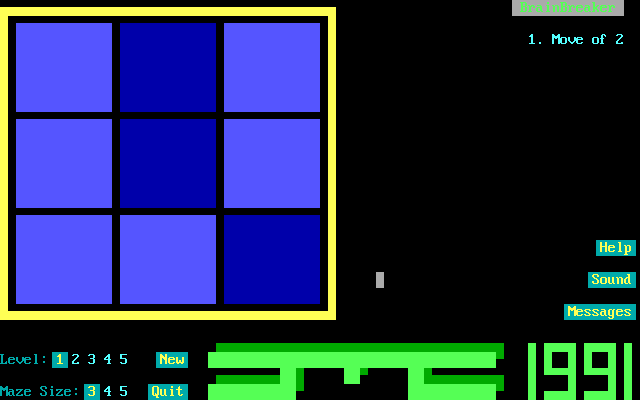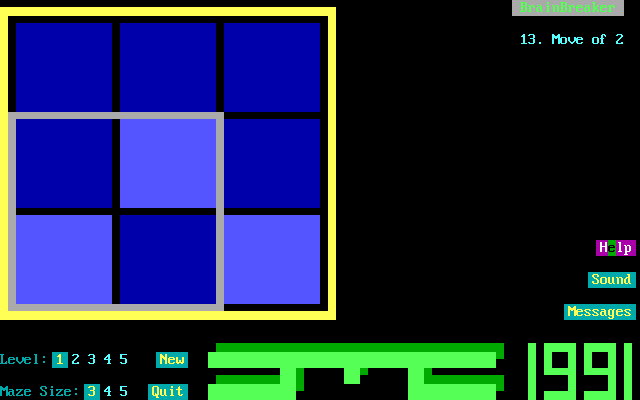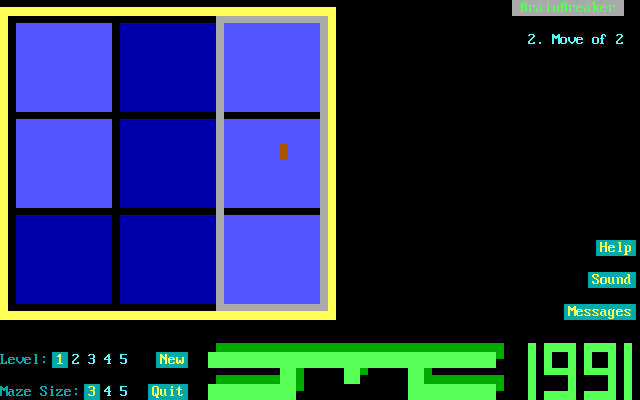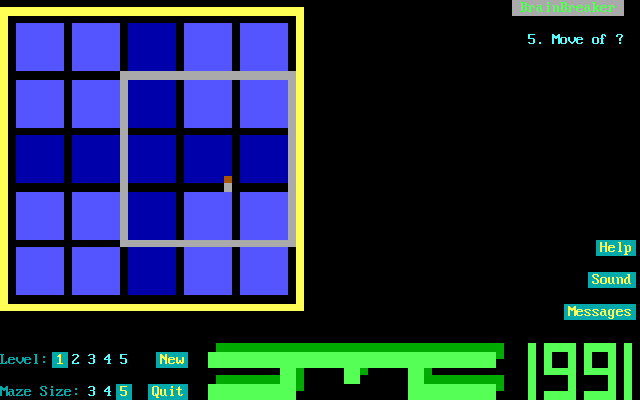Retro Replay Review
Gameplay
BrainBreaker is a deceptively simple puzzle game that challenges players to turn an entire grid dark in as few moves as possible. Boards come in sizes ranging from 3×3 to 5×5, and each move flips an entire contiguous area of cells—whether it’s a 1×3 strip, a 2×2 square, or any other shape you can form within the grid. The catch? Light cells go dark and dark cells go light. This mechanic pushes you to anticipate chain reactions and plan your sequence of flips carefully.
(HEY YOU!! We hope you enjoy! We try not to run ads. So basically, this is a very expensive hobby running this site. Please consider joining us for updates, forums, and more. Network w/ us to make some cash or friends while retro gaming, and you can win some free retro games for posting. Okay, carry on 👍)
There’s no losing state in BrainBreaker—your only metric of failure is a suboptimal move count. This design choice means the game is accessible to anyone who loves puzzles, yet it still offers a deep strategic layer for completionists. Every move carries weight: a single misstep can undo hours of meticulous planning, and solving a large grid with a minimal move count becomes a satisfying triumph.
To ease you into its brain-teasing levels, BrainBreaker provides an on-demand hint system. Tap the help button, and the game will highlight a viable move to proceed. Use it once, or use it a dozen times—the choice is yours. This feature is especially useful for newcomers to sliding-flip puzzles, while veterans can bypass hints entirely for a purist challenge.
The move counter serves as both score and motivator. As you progress through more complex puzzles, you’ll find yourself replaying levels to shave off one or two extra moves. This loop of trial, error, and eventual mastery keeps the gameplay addictively looped, ensuring you’re engaged long after you think the grids have no more secrets.
Graphics
BrainBreaker’s visual design embraces minimalism. Each grid cell is rendered in stark blacks and bright whites, with clean lines delineating the board boundaries. This deliberate simplicity prevents visual clutter, allowing you to focus entirely on your next strategic flip without distraction.
Despite its minimalist approach, BrainBreaker feels polished. Subtle animations accompany each flip—cells smoothly transition from light to dark or vice versa, providing satisfying feedback on every move. These micro-interactions add a tactile feel that’s remarkably engaging for a puzzle game of this scale.
The color palette, while limited, is carefully chosen to reduce eye strain during long play sessions. The contrast is high enough to distinguish each cell clearly, even on smaller screens, and the game’s responsive interface ensures that taps and swipes translate instantly into board updates.
Sound design complements the visuals with gentle clicks and whooshes as cells flip. It’s unobtrusive yet gratifying, reinforcing each action without overwhelming the quiet concentration puzzle-solving demands. Together, the audio-visual package feels complete and purposeful.
Story
If you’re looking for a narrative-driven adventure, BrainBreaker is not your typical story-rich title. It doesn’t feature characters, dialogues, or a plot that unfolds over chapters. Instead, its “story” is abstract—centered entirely on the concept of moving from light to darkness through logical progression.
This abstract narrative framework can be surprisingly compelling. As you progress, the game subtly communicates a sense of descent into complexity. Beginner levels introduce simple patterns, but before long you’re navigating labyrinthine flips that feel almost like thematic “boss battles” against the grid itself.
While there’s no lore or backstory, the progression of difficulty creates a kind of emergent narrative. Each solved puzzle marks a milestone in your personal journey, building a sense of accomplishment that echoes through subsequent levels. It’s a reminder that sometimes, the purest form of storytelling in games is the story you write on the grid with every strategic move.
For players who thrive on dichotomies, the light-versus-dark motif at the core of BrainBreaker serves as its own thematic undercurrent. You are both the creator of clarity and the harbinger of darkness; every cell you flip carries a dual meaning that transcends mere puzzle mechanics.
Overall Experience
BrainBreaker may be small in scope, but it punches well above its weight in strategic depth. The core challenge—flip everything dark in as few moves as possible—is easy to grasp but difficult to master. As you transition from 3×3 grids to 5×5 puzzles, you’ll find yourself fully immersed in the rhythm of planning and execution, chasing that satisfying “aha” moment with every level.
The inclusion of an unlimited hint system ensures that frustration never turns into abandonment. Whether you’re a casual puzzle fan or a seasoned problem-solver, BrainBreaker adapts to your skill level, offering gentle guidance or pure, unfiltered challenge depending on how you choose to play.
Graphically, the game’s minimalist aesthetic is more than just a stylistic choice—it’s a tool that keeps your focus razor-sharp. The intuitive interface, paired with crisp animations and subtle sound effects, creates a seamless puzzle experience that feels polished and complete.
Ultimately, BrainBreaker stands as a testament to the power of elegant game design. In just a handful of grid cells, it offers hours of engaging brain-teasing fun. If you love puzzles and don’t need a heavy narrative backdrop to stay invested, this is one small game that delivers big satisfaction.
 Retro Replay Retro Replay gaming reviews, news, emulation, geek stuff and more!
Retro Replay Retro Replay gaming reviews, news, emulation, geek stuff and more!








Reviews
There are no reviews yet.